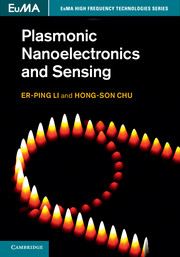Book contents
- Frontmatter
- Contents
- List of contributors
- Preface
- 1 Fundamentals of plasmonics
- 2 Plasmonic properties of metal nanostructures
- 3 Frequency-domain methods for modeling plasmonics
- 4 Time-domain simulation for plasmonic devices
- 5 Passive plasmonic waveguide-based devices
- 6 Silicon-based active plasmonic devices for on-chip integration
- 7 Plasmonic biosensing devices and systems
- Index
- References
5 - Passive plasmonic waveguide-based devices
Published online by Cambridge University Press: 05 March 2014
- Frontmatter
- Contents
- List of contributors
- Preface
- 1 Fundamentals of plasmonics
- 2 Plasmonic properties of metal nanostructures
- 3 Frequency-domain methods for modeling plasmonics
- 4 Time-domain simulation for plasmonic devices
- 5 Passive plasmonic waveguide-based devices
- 6 Silicon-based active plasmonic devices for on-chip integration
- 7 Plasmonic biosensing devices and systems
- Index
- References
Summary
This chapter presents the hybrid plasmonic waveguide (HPW) platform and its components. In particular, the effective mode index, propagation distance, and mode confinement of the planar vertical hybrid plasmonic waveguides (VHPWs) are numerically characterized as functions of dimensions and materials in the near-infrared wavelengths. The chapter demonstrates that the vertical hybrid silver–silica–silicon plasmonic waveguide achieves better propagation characteristics than those of the counterpart silver–silica–silver MIM and silicon-based dielectric-loaded plasmonic waveguide. Moreover, we propose and design various passive waveguide-based components based on the optimized VHPW, including bends, power-splitters, couplers, and ring resonator filters. An important issue is how to implement these HPW-based components and devices in standard complementary metal–oxide–semiconductor (CMOS) electronic–photonic integrated circuits. To meet this requirement, two CMOS-compatible HPW platforms, namely a copper-cap VHPW and a hybrid horizontal copper–silicon dioxide–siliconsilicon dioxide–copper plasmonic waveguide, and devices based on them such as bends and ring resonator filters are subjected to further investigation both in experiments and in theory in the subsequent sections.
Introduction
In the context of communications and information processing, integration of photonic and nanoelectronic devices on the same chip would lead to a tremendous synergy by combining the ultra-compactness of nanoelectronics with the super-wide bandwidth of photonics. Such integration will benefit considerably from the application of nanotechnology for data-processing, sensing, medical, health-care, and energy purposes. In recent years, it has been demonstrated theoretically and experimentally that plasmonic devices, taking advantage of plasmon-enabled tight modal confinement, promise to overcome the size mismatch between microscale photonics and nanoscale electronics.
- Type
- Chapter
- Information
- Plasmonic Nanoelectronics and Sensing , pp. 139 - 179Publisher: Cambridge University PressPrint publication year: 2014
References
- 1
- Cited by

